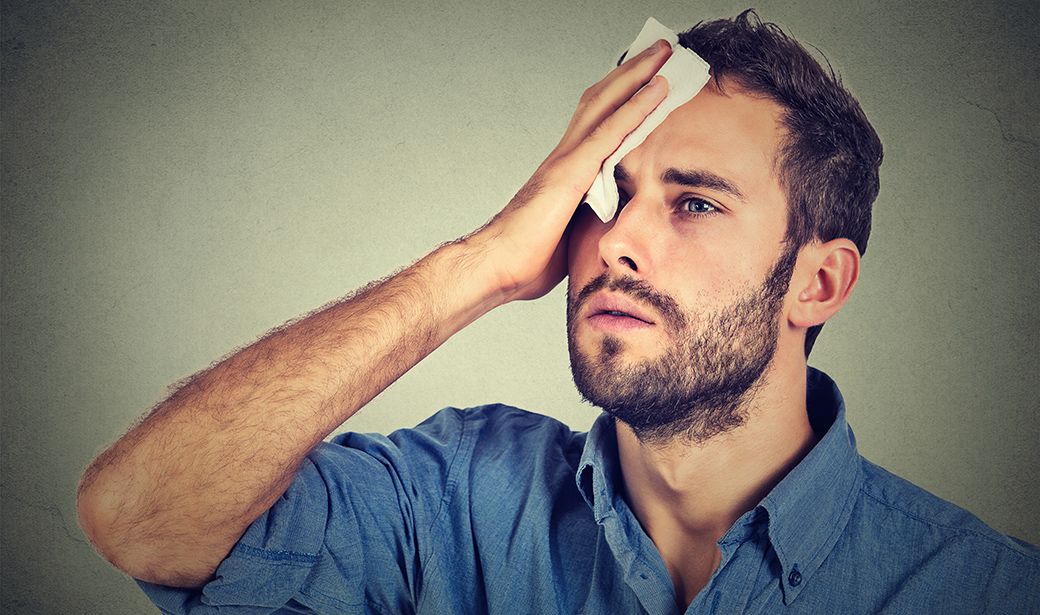Approximately five percent of the global population suffers from excessive sweating, known clinically as hyperhidrosis. Many people who live with this condition have no idea that they can find relief. Kari Martin, MD, a pediatric dermatologist who works with hyperhidrosis patients of all ages, shares how MU Health Care’s dermatology team is improving the lives of people with this uncomfortable — and completely treatable — condition.
What is hyperhidrosis?
Excessive sweating is caused by overactive sweat glands, and it is most common after puberty. Although it’s most common in the hands, feet and underarms, Martin sees plenty of patients with excessive sweating in their trunk, face or scalp as well. For many people, she says, “they’ve always felt, ‘something’s wrong with me, and this is just how I have to be.’”
Martin says that rather than getting help, “a lot of patients will have adapted their way of life to deal with their sweating. For example, if they have really sweaty feet, they’ll slide around in flip-flops or sandals, so they just no longer wear sandals — they’ll only wear tennis shoes. Or if they sweat a lot in their armpits, they won’t wear gray shirts. They’ll only wear white shirts or light-colored shirts. Or if they sweat a lot from their hands, that’s the worst socially because they tend to not shake hands with people. With kids in school, their hand sticks to the paper when they’re writing, or their hand slips when they’re playing sports or steering a car.” The condition is especially hard on teenagers, who feel the effects of social isolation and embarrassment particularly acutely.
Treatment options
Martin wants people to know that they don’t have to continue living with the effects of hyperhidrosis. “They don’t realize that this is a fairly common problem and that there are treatments we can use to minimize their symptoms so they can go back to living a normal life.”
Below are a few of the most common treatment options for hyperhidrosis.
Topical antiperspirants: “Aluminum chloride is a liquid that comes with an applicator that you rub on the skin, and it dries,” explains Martin. “It’s cheap, and there are very few side effects other than skin irritation. So we usually start with that, and it’s effective for quite a few people.”
Injections: Botulinem toxin, known most commonly by the brand name BOTOX, can be injected into the affected area to temporarily block the chemical process that activates the body’s sweat glands.
Ionophoresis: According to Martin: “Ionophoresis is a treatment that involves an electrical current going through water to change how the sweat glands work. It works best for hands and feet. Patients submerge their hands and feet in a shallow water bath, and a low current is sent through the water.”
Other treatments available include oral medication and microwave therapy.
Life after treatment
“I have a patient who is a bank teller,” Martin says. “Her hands would sweat really badly, so she had a hard time doing her job well because she was sorting money and shaking people’s hands. She would just avoid shaking hands or handing over sweaty piles of money. Treatment was life-changing for her. She felt so much more confident at work and that she could do the job that she wanted to do.”
Martin also sees huge improvements in the lives of her teenage patients. “Being a teenager is hard enough as it is,” she says. “If you have hyperhidrosis and you’re a teenager, it can really help you with your confidence if you can get your sweating down to the range of all of your peers.”
For people with questions about hyperhidrosis, Martin recommends they visit sweathelp.org, run by the International Hyperhidrosis Association. To learn more about how Martin and the MU Dermatology team are improving the lives of people with this and other conditions, click here.



